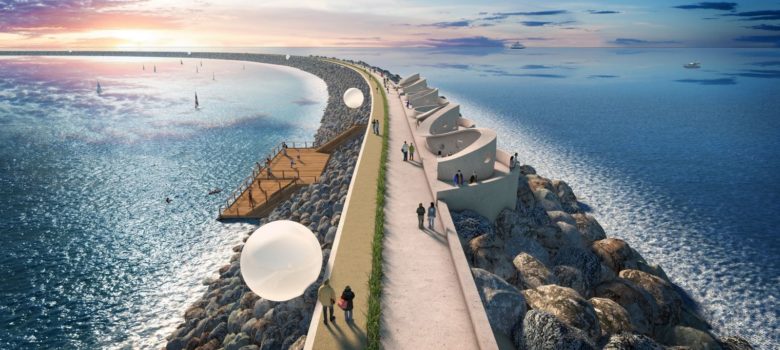
National newspapers are reporting that the government plans to reject the Swansea tidal lagoon project as soon as this week.
What is the Swansea tidal lagoon?
We are big fans of tidal power. Tidal lagoons work in a similar way to tidal barrages, but differ in that they do not form a barrier all the way across a coastline or estuary. They can be sited offshore, and consist of a (normally circular) perimeter embankment impounding water. Energy production works in two ways: at high tide, a barrier goes up and water rushes into the lagoon through turbines, generating kinetic energy. At low tide, water that has built up inside the lagoon does the same on its way out. The structure looks like a sea wall at low tide, and disappears under the water at high tide. Because of the nature of tides, the tidal lagoons do not produce power consistently, but when they get going they can generate huge amounts. There’s also reliability – unlike other forms of renewable energy, such as wind turbines and solar PV, the energy output of a tidal lagoon plant is entirely predictable.
Because tidal lagoons don’t form a blockade across a large area of coastline, they are less ecologically damaging than barrages. Fish can swim around the structures, and the movement of silt is not as affected. However, people have still raised concerns about the environmental impact.
The Swansea Tidal Lagoon would be theoretically capable of generating 320MW – enough to power more than 155,000 homes. Its life expectancy is around 120 years – twice that of a well performing nuclear plant.
Why is the government expected to pull funding from the Swansea tidal lagoon?
First reported in the Financial Times last week and repeated by several other news outlets since. The basic problem is that Tidal Lagoon Power (TLP), who are running the show, are requesting more money from the government than it’s willing to spend. Although the vast majority of the £1.3 billion project is privately funded, the lagoon still requires significant financial input.
To make things more complicated, there’s a certain amount of national tension involved; the levels of support for the project are much higher in Wales than Westminster. According to the Financial Times, the Welsh government has pledged over £200 million in financial support, but the scheme still requires the blessing of the central British government. The difference in opinion between the two inevitably leads to discussion of increased Welsh autonomy and the question of devolution – suddenly the Swansea tidal lagoon goes from a potentially industry changed investment in renewable energy, to a political bargaining chip.
The Swansea tidal lagoon was set to be the first of several such installations around the UK. This was hailed as the ‘pathfinder’ project, the kind of first trial to see what happened. But, a bit like the first pancake in a batch, there’s always the risk that it will not perform as expected and the entire thing will have to go in the bin (a tragedy, whether it’s billion pound investments or the first crepe of pancake day). That’s why the government is so loathe to spend money on it – it’s a new idea for the UK and it could be considered a bit of a gamble. One that, perhaps unsurprisingly, our somewhat precariously positioned government does not seem keen to take.
What will they do instead?
The real alternative, and the one that seems most likely to happen, is the proposed Wylfa nuclear power station. It’s strongly expected that an announcement is imminent confirming the rejection of the Swansea lagoon and also announcing plans to move forward with Wylfa.
Despite talking a good talk about wanting to explore different proposals, the Department for Business, Energy and Industrial Strategy have made some pretty negative comments; “We have a responsibility to minimise the impact on consumer bills and the Swansea proposal is more than twice as expensive as the Hinkley power station… Any decision on the Swansea Bay tidal lagoon project will have to represent value for money for the UK taxpayer as well as the consumer.” This is refuted by TLP, who claim that the unit price for the tidal lagoon would not necessarily have to cost more.
At the moment, the future of the Swansea tidal lagoon – and all subsequent tidal projects – is still uncertain. Although it is expected that the government will imminently come out against the project, at the time of writing we are just not sure. Only time will tell.












No Comments yet! Be the first one.